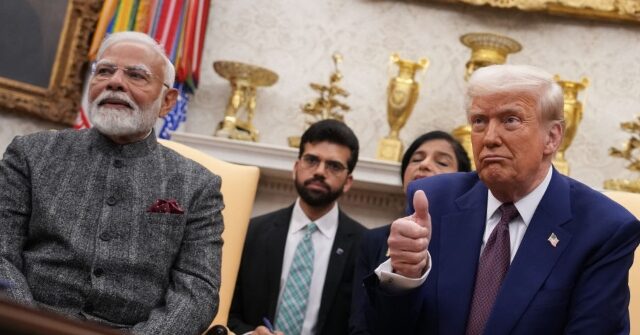Indian government sources told Reuters on Tuesday that New Delhi is considering $23 billion in tariff reductions on U.S. imports to stave off President Donald Trump’s threatened reciprocal tariffs, which will affect at least $66 billion in Indian exports if they take effect on April 2.
According to Reuters’ sources, the Indian government ran the numbers and concluded it will fare much better by lowering its tariffs, even though it will lose a great deal of income:
In an internal analysis, New Delhi estimated such reciprocal tariffs would hit 87% of its total exports to the United States worth $66 billion, two government sources with knowledge of the matter told Reuters.
Under the deal, India is open to reducing tariffs on 55% of U.S. goods it imports that are now subject to tariffs ranging from 5% to 30%, said both sources, who sought anonymity as they were not authorized to speak to the media.
…
Overall the U.S. trade-weighted average tariff has been about 2.2%, data from the World Trade Organization shows, compared with India’s 12%. The United States has a trade deficit of $45.6 billion with India.
This resolution to the tariff standoff would probably please the Trump White House, which had specific non-trade reasons for imposing some tariffs (such as demanding better border security from Canada and an end to the fentanyl tidal wave from China) but argued that other trade partners have been getting away with one-sided tariffs on American exports for too long.
President Trump has been particularly tough on India as a “tariff abuser,” while insisting he wants to maintain good relations with New Delhi and considers Prime Minister Narendra Modi a personal friend.
“India is also considering wider tariff reform to lower barriers uniformly, but such discussions are in early stages and might not figure immediately in talks with the United States,” Reuters noted.
The BBC, while not generally a Trump-friendly outlet, conceded last week that the American president has a point about India’s “protectionism”:
High tariffs increase costs for companies dependent on global value chains, hindering their ability to compete in international markets. They also mean that Indians pay more on imported goods than foreign consumers. Despite growing exports — primarily driven by services — India runs a significant trade deficit. However, with India’s share of global exports at a mere 1.5%, the challenge becomes even more urgent.
…
Last month, ahead of Prime Minister Modi’s meeting with Trump in Washington, India unilaterally lowered tariffs on Bourbon whiskey, motorcycles, and some other US products.
India’s tariff reduction on bourbon was substantial, reducing the rate from 150 percent to 100 percent — which still leaves 100 percent tariffs in place.
The Hindustan Times noted when the tariffs were reduced that a substantial market for imported bourbon exists, but the market will not flourish while Indian customers are paying double sticker price for every bottle. As long as tariffs remain so high, exporters are unlikely to make large investments in shipping and marketing, so protectionism becomes a self-fulfilling prophecy of limited demand.
The Australian Strategic Policy Institute (ASPI) thought Trump’s “unpredictability” might just be enough to shake India out of its protectionism — but India could also break in an undesirable direction if Trump pushes too hard, seeking “alternative markets” for its exports instead of accepting the loss of tariff advantages that are sustaining entire industries:
One analysis estimates that India effectively imposes a 9.5 percent tariff on US goods, while US levies on Indian imports are only 3 percent. If Trump follows through on his pledge of full tariff reciprocity, that imbalance will vanish — along with the cost advantages many Indian exporters currently enjoy. Indian products will become less competitive, leading to a decline in export revenues and job losses, especially in labour-intensive industries. Critical sectors — including chemicals, metals, jewellery, automobiles and auto parts, textiles, pharmaceuticals, and food products — are expected to be hit the hardest.
India will have to choose its strategy fairly quickly, as President Trump has specified April 2 as the day when all countries imposing tariffs on U.S. exports will face reciprocal action. Trump has been referring to April 2 as “Liberation Day.”
The White House has, however, been hinting over the past few days that the April 2 tariffs could be “narrower” than President Trump’s original vision.
“One of the things we see from markets is they’re expecting… these really large tariffs on every single country. I think markets need to change their expectations, because it’s not everybody that cheats us on trade, it’s just a few countries and those countries are going to be seeing some tariffs,” National Economic Council director Kevin Hassett said.
As noted above, India has one of the largest tariff disparities with the United States, but it remains to be seen if those tariffs will be judged “cheating on trade” when Liberation Day rolls around.
Read the full article here
